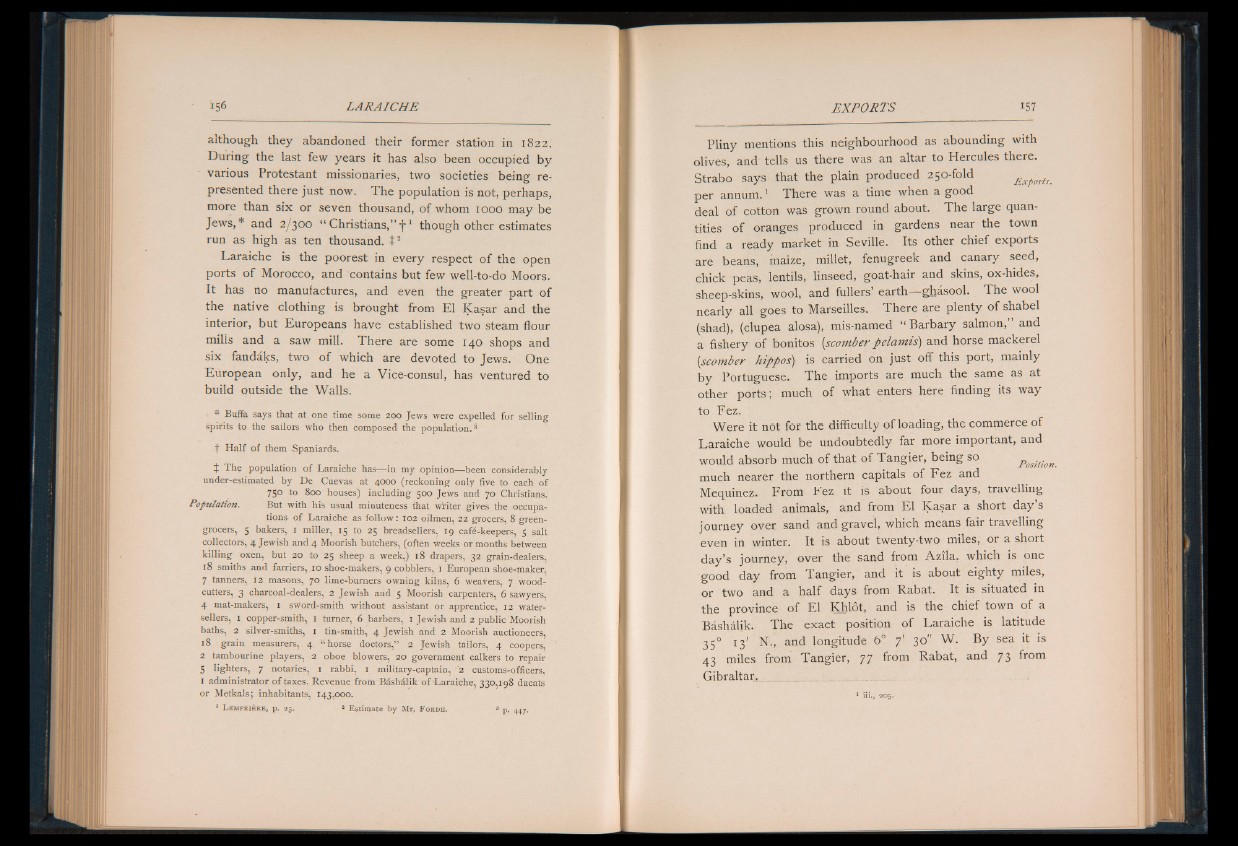
although they abandoned their former station in 1822.
During the last few years it has also been occupied by
various Protestant missionaries, two societies being represented
there just now. The population is not, perhaps,
more than six or seven thousand, of whom 1000 may be
Jews,* and 2/300 “ Christians,” •J1 though other estimates
run as high as ten thousand, t 2
Laraiche is the poorest in every respect of the open
ports of Morocco, and contains but few well-to-do Moors.
It has no manufactures, and even the greater part of
the native clothing is brought from El Kasar and the
interior, but Europeans have established two steam flour
mills and a saw mill. There are some 140 shops and
six fandaks, two of which are devoted to Jews. One
European only, and he a Vice-consul, has ventured to
build outside the Walls.
* Buffa says that at one time some 200 Jews were expelled for selling
spirits to the sailors who then composed the population.3
f Half of them Spaniards.
t The population of Laraiche has— in my opinion— been considerably
under-estimated by De Cuevas at 4000 (reckoning only five to each of
750 to 800 houses) including 500 Jews and 70 Christians.
Population. But with his usual miuuteness that wtiter gives the occupations
of Laraiche as follow: 102 oilmen, 22 grocers, 8 greengrocers,
5 bakers, 1 miller, 15 to 25 breadsellers, 19 cafe-keepers, 5 salt
collectors, 4 Jewish and 4 Moorish butchers, (often weeks or months between
killing oxen, but 20 to 25 sheep a week,) 18 drapers, 32 grain-dealers,
18 smiths and farriers, 10 shoe-makers, 9 cobblers, 1 European shoe-maker,
7 tanners, 12 masons, 70 lime-burners owning kilns, 6 weavers, 7 woodcutters,
3 charcoal-dealers, 2 Jewish and 5 Moorish carpenters, 6 sawyers,
4 mat-makers, 1 sword-smith without assistant or apprentice, 12 water-
sellers, 1 copper-smith, 1 turner, 6 barbers, 1 Jewish and 2 public Moorish
baths, 2 silver-smiths, 1 tin-smith, 4 Jewish and 2 Moorish auctioneers,
18 grain measurers, 4 “ horse doctors,” 2 Jewish tailors, 4 coopers,
2 tambourine players, 2 oboe blowers, 20 government calkers to repair
5 lighters, 7 notaries, 1 rabbi, 1 military-captain, 2 customs-officers,
1 administrator of taxes. Revenue from Bashal ik of Laraiche, 330,198 ducats
or Metkals; inhabitants, 143,000.
1 L e m p r i e r e , p . 25. 2 E s t im a te b y M r . F o r d e . 3 p . 447.
Pliny mentions this neighbourhood as abounding with
olives, and tells us there was an altar to Hercules there.
Strabo says that the plain produced 250-fold Exforts,
per annum.1 There was a time when a good
deal of cotton was grown round about. The large quantities
of oranges produced in gardens near the town
find a ready market in Seville. Its other chief exports
are beans, maize, millet, fenugreek and canary seed,
chick peas, lentils, linseed, goat-hair and skins, ox-hides,
sheep-skins, wool, and fullers’ earth— ghasool. The wool
nearly all goes to Marseilles. There are plenty of shabel
(shad), (clupea alosa), mis-named “ Barbary salmon,” and
a fishery of bonitos (scomber pelamis) and horse mackerel
(scomber hippos) is carried on just off this port, mainly
by Portuguese. The imports are much the same as at
other ports; much of what enters here finding its way
to Fez.
Were it not for the difficulty of loading, the commerce of
Laraiche would be undoubtedly far more important, and
would absorb much of that of Tangier, being so Posiiion,
much nearer the northern capitals of Fez and
Mequinez. From Fez it is about four days, travelling
with loaded animals, and from El Kasar a short day s
journey over sand and gravel, which means fair travelling
even in winter. It is about twenty-two miles, or a short
day’s journey, over the sand from Azila, which is one
good day from Tangier, and it is about eighty miles,
or two and a half days from Rabat. It is situated in
the province of El Khlot, and is the chief town of a
Bashahk. The exact position of Laraiche is latitude
350 13' N., and longitude 6° 7' 30” W. By sea it is
43 miles from Tangier, 77 fro**1 Rabat, and 73 fr°m
Gibraltar.
1 iii., 205.